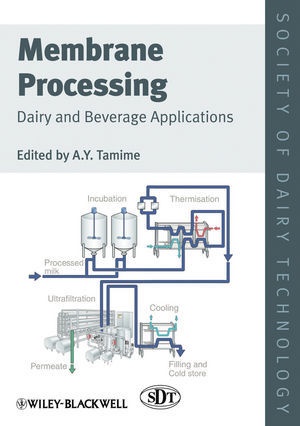Read more
Informationen zum Autor A.Y. Tamime is a Consultant in Dairy Science and Technology, Ayr, UK. He is the Series Editor of the SDT's Technical Book Series. Klappentext In the last two decades, there have been significant developments in membrane filtration processes for the dairy and beverage industries. The filtration systems can be classified into four main groups: reverse osmosis, nanofiltration, ultrafiltration and microfiltration. The primary objective of this book is to assess critically the pool of scientific knowledge available to the dairy and beverages industry, as a tool for process and product innovation, quality improvement and safety.The book is divided into three main parts. Part I reviews the principals, developments and designs of membrane processes that are mainly used in commercial dairy and beverage applications. Part II provides information on the applications of membrane processes in the manufacture of dairy products, from on-farm concentration of milk as a pre-treatment for cheesemaking to fractionation of milk and whey to provide ingredients for food and other applications. Part III considers membrane applications during the manufacture of fruit juices, beer and cider, wine and vinegar. These include concentration, deacidification and dealcoholisation processes.Membrane Processing: Dairy and Beverages Applications is an ideal new reference for dairy and beverage processors involved in the application of membranes, both to aid the creation of novel products, and to improve their process economics. Students and lecturers of food and dairy science and technology will value its in-depth discussion of membrane processes, whilst readers based in the dairy industry will prize it as the most up-to-date and advanced volume yet published on this crucially important topic. "In summary, a very worthwhile addition to the series that provides an excellent source for those working with this technology." ( International Journal of Dairy Technology , 3 August 2013) Zusammenfassung Suitable for dairy and beverage processors involved in the application of membranes, both to aid the creation of novel products, and to improve their process economics, this title reviews the principals, developments and designs of membrane processes that are mainly used in commercial dairy and beverage applications. Inhaltsverzeichnis Preface to the Technical Series xiii Preface xv Contributors xvii 1 Development of Membrane Processes 1 K. Smith 1.1 Historical background 1 1.2 Basic principles of membrane separations 3 1.2.1 Depth versus screen filters 3 1.2.2 Isotropic versus anisotropic membranes 4 1.2.3 Cross-flow filtration 5 1.2.4 Requirements of membrane processes 7 1.3 Types of membrane separations 8 1.3.1 Reverse osmosis 8 1.3.2 Nanofiltration 8 1.3.3 Ultrafiltration 9 1.3.4 Microfiltration 9 1.4 Theory of membrane transport 9 1.4.1 Transport models 9 1.4.2 Reverse osmosis/nanofiltration membranes 10 1.4.3 Ultrafiltration/microfiltration membranes 11 1.5 Factors affecting membrane separations 11 1.5.1 Factors affecting reverse osmosis/nanofiltration separations 11 1.5.2 Factors affecting ultrafiltration/microfiltration separations 12 1.5.3 System parameters 13 1.6 General characteristics of membrane processes 13 1.6.1 Retention and rejection 13 1.6.2 Pore size 14 1.6.3 Molecular weight cut-off 14 1.6.4 Flux 14 1.6.5 Concentration factor 15 1.6.6 Membrane life 15 1.7 Conclusion and future development 15 Suggested literature 15 2 Principles of Membrane Filtration 17 A. Hausmann, M.C. Duke and T. Demmer 2.1...
List of contents
Preface to the Technical Series xiii
Preface xv
Contributors xvii
1 Development of Membrane Processes 1
K. Smith
1.1 Historical background 1
1.2 Basic principles of membrane separations 3
1.3 Types of membrane separations 8
1.4 Theory of membrane transport 9
1.5 Factors affecting membrane separations 11
1.6 General characteristics of membrane processes 13
1.7 Conclusion and future development 15
Suggested literature 15
2 Principles of Membrane Filtration 17
A. Hausmann, M.C. Duke and T. Demmer
2.1 Introduction and definitions 17
2.2 Membrane properties based on materials 24
2.3 Flux behaviour in pressure-driven membrane operations 29
2.4 Effects of feed characteristics and operating parameter on separation efficiency 37
2.5 Cross-flow systems 43
2.6 Recent membrane processes following different operating principles 44
2.7 Conclusions 47
References 47
3 Commercial Membrane Technology 52
K. Smith
3.1 Introduction: polymers used in membrane manufacture 52
3.2 Other materials used for membranes 56
3.3 Membrane configuration 58
3.4 Modes of operation 65
3.5 Conclusion and future developments 71
Suggested literature 71
4 Membrane Fouling, Cleaning and Disinfection 73
L.L.A. Koh, M. Ashokkumar and S.E. Kentish
4.1 Introduction 73
4.2 Flux reduction 73
4.3 Membrane cleaning and disinfection 84
4.4 Recent developments 98
4.5 Conclusions 99
4.6 Nomenclature 100
References 102
5 General Application for the Treatment of Effluent and Reuse of Wastewater 107
N.A. Milne and S.R. Gray
5.1 General wastewater quality issues 107
5.2 General wastewater treatment 108
5.3 Water reuse 117
5.4 Conclusions and future applications 123
References 124
6 Liquid Milk Processing 128
G. Gesan-Guiziou
6.1 Introduction 128
6.2 On-farm concentration of milk 128
6.3 Protein standardisation by ultrafiltration 130
6.4 Removal of bacteria by microfiltration 134
6.5 Fractionation of fat 138
6.6 Removal of somatic cells by microfiltration 139
6.7 Conclusions and future trends 140
References 140
7 Membrane Processing of Fermented Milks 143
B. Ozer and A.Y. Tamime
7.1 Introduction 143
7.2 Microflora of the starter cultures 144
7.3 Patterns of production and consumption 145
7.4 Manufacturing practice of gel-type (set and stirred) products 145
7.5 Manufacturing practice of concentrated products 152
7.6 Quality control 158
7.7 Conclusion 169
References 170
8 Cheese 176
V.V. Mistry
8.1 Background 176
8.2 Properties of membrane processed concentrates 177
8.3 Applications of ultrafiltration in cheesemaking 178
8.4 Cheese quality 185
8.5 Applications of microfiltration in cheesemaking 186
8.6 Nanofiltration 188
8.7 Milk protein concentrates 189
8.8 Future potential 189
References 190
9 Whey Processing 193
L. Ramchandran and T. Vasiljevic
9.1 Introduction 193
9.2 Whey: components, their functionality and uses 193
9.3 Problems of traditional whey processing 195
9.4 Membranes in whey processing 196
9.5 Conclusions 204
References 205
10 Concentrated Milk and Powders 208
Report
"In summary, a very worthwhile addition to the series thatprovides an excellent source for those working with thistechnology." ( International Journal of DairyTechnology , 3 August 2013)

